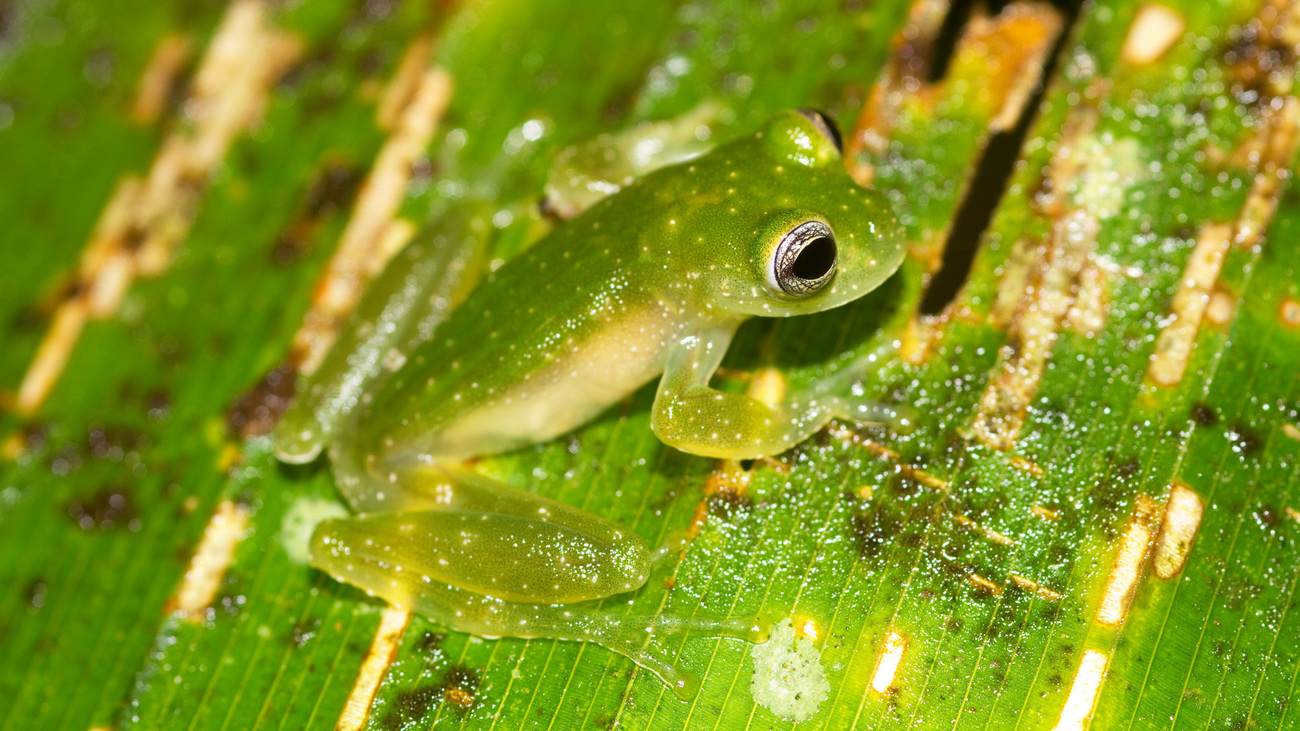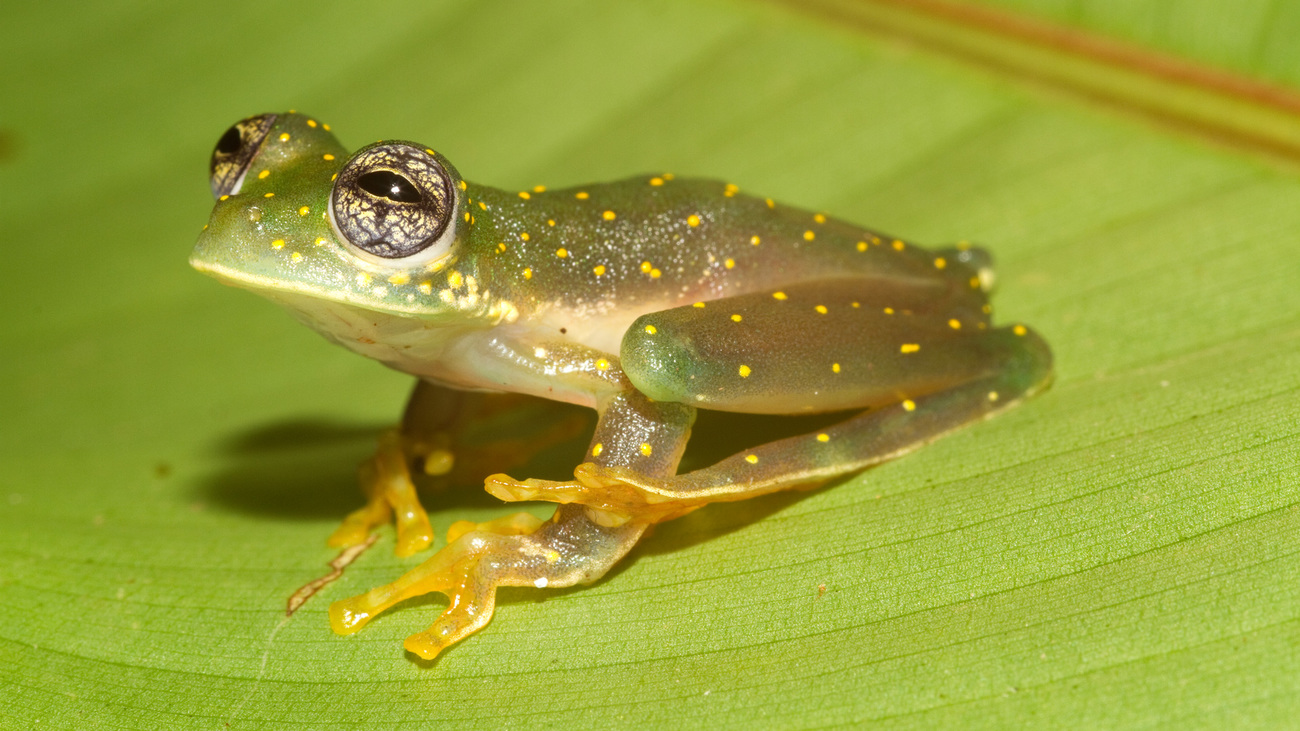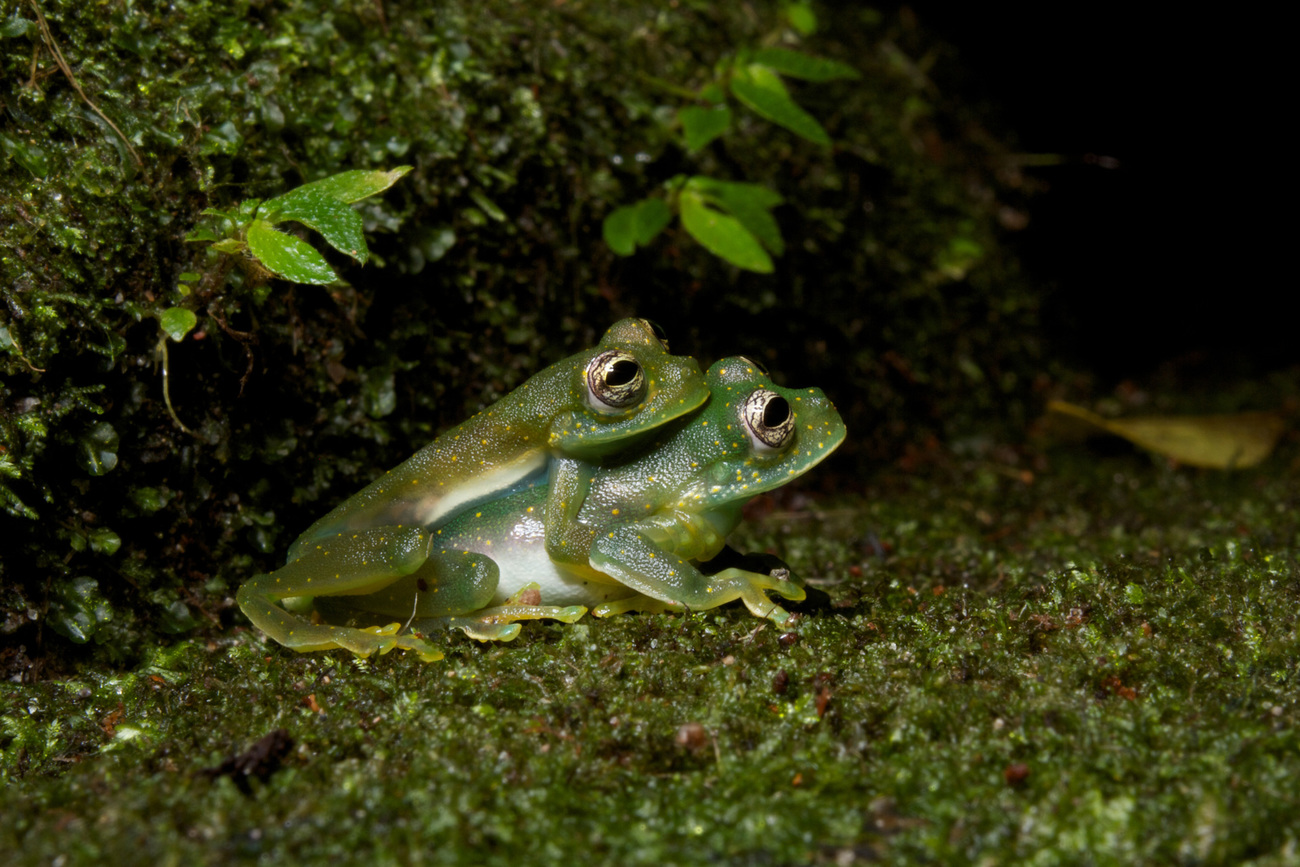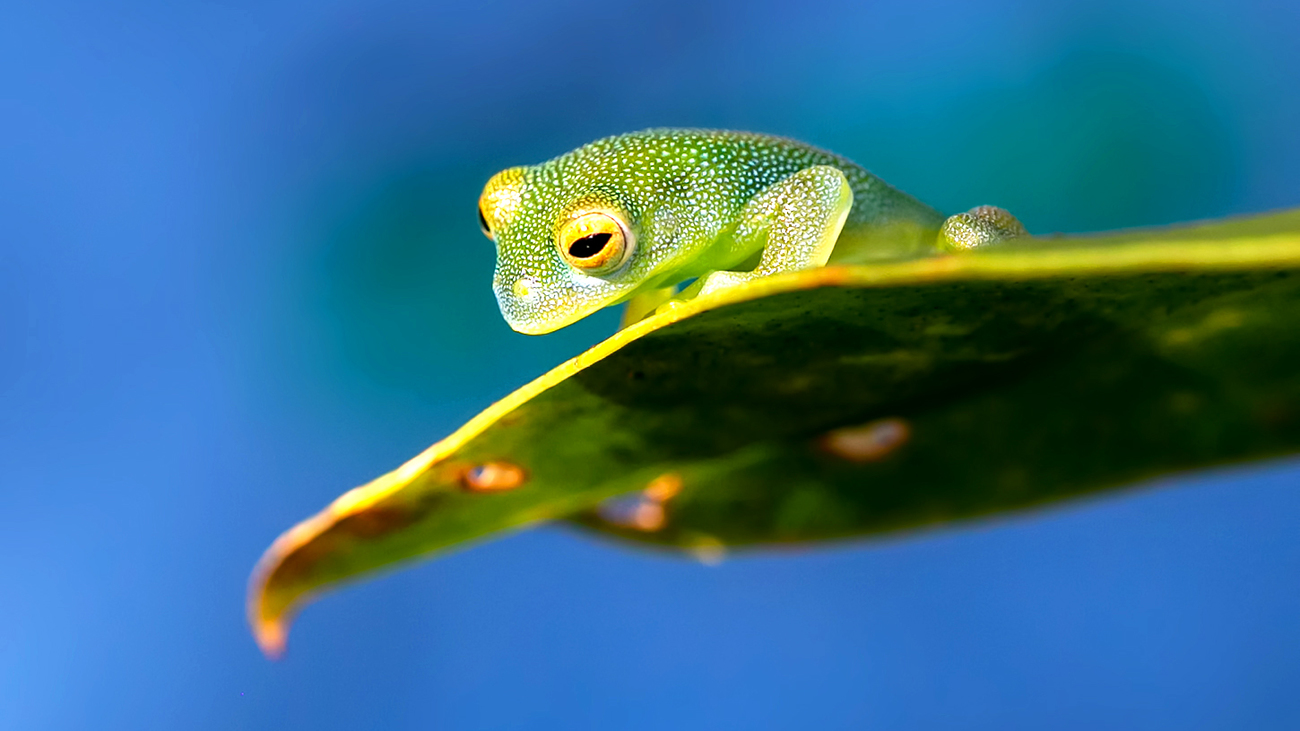Glass frogs
What is a glass frog?
Glass frogs are a striking group of around 160 species that all share an amazing adaptation—they are translucent! When you look at a glass frog’s belly, you can see right inside its body. You can see its heart beating or food passing through its digestive system. Of course, this rare characteristic isn’t really for showing off organs. It helps glass frogs blend seamlessly into their surroundings, making it much more difficult for predators to differentiate them from the leaf or branch on which they’re sitting.
Glass tree frogs live in rainforests and mountainous forests across Central and South America. They spend the dry season high in the canopy and spend the mating season lower to the ground. As part of their mating ritual, male glass frogs find leaves hanging just above a stream and call to females. When a female arrives, he wraps himself around her to fertilize her eggs as she lays them. The eggs stick to the leaf, and depending on the species of glass frog, the mother and/or father spend time protecting their eggs before they’re ready to hatch. In some species, females protect their eggs through the night after they’re laid, improving their chance of survival. Scientists have observed that males spend a longer time protecting the eggs after the female leaves. Once they’re ready to hatch, the tadpoles emerge from their eggs and fall into the water below the leaf. They stay in the water for as long as 10 months, and once they’re adults, they can live for up to 14 years.
These frogs act as predators, prey, and bioindicators. This means they’re active members of their ecosystems and their presence in a given area suggests that many other species are thriving there as well.
What is a glass frog’s scientific name?
Around 160 species of glass frogs have been discovered so far, and all of them have their own scientific names. These species fall within 12 different genera, but they are all members of the Centrolenidae family.
Because there are such a large number of separate species, some of which live very close together and are small in number, not every species has a common name. Some are only known by their scientific names.
Are glass frogs endangered?
Out of all of the glass frog species evaluated by the IUCN, around half are considered threatened to some degree. There are 11 species listed as critically endangered, 39 listed as endangered, 19 listed as vulnerable, and 11 listed as near threatened.
The 11 critically endangered species are:
- Buckley’s glass frog (Centrolene buckleyi)
- Maduriacu glass frog (Nymphargus manduriacu)
- Ridge cochran frog (Cochranella euhystrix)
- Trueb’s cochran frog (Nymphargus truebae)
- Wiley’s glass frog (Nymphargus wileyi)
- Nymphargus mixomaculatus
- Nymphargus armatus
- Large-headed glass frog (Nymphargus megacheirus)
- Pacific giant glass frog (Centrolene geckoidea)
- Sucre’s glass frog (Nymphargus sucre)
- Amazon giant glass frog (Centrolene pipilata)
The exotic pet trade, habitat loss, and climate change threatens all species of glass frogs.
Where do glass frogs live?
Glass frogs are found in forests in several countries, including Belize, Colombia, Honduras, Costa Rica, Guatemala, Mexico, and Panama.
They’re not easy to find, though. Glass frogs are arboreal or tree frogs and spend a lot of time high up in the canopies. They’re also nocturnal, and during the day, they enter a super-camouflaged state while sleeping on tree leaves.
Glass frogs usually stay close to water because they lay their eggs in streams, and many of the forests in which they live are rainforests or humid mountain forests. Different types of glass frogs often live quite close together but maintain enough genetic variance to classify them as separate species.
Threats
Glass frogs face a number of threats such as habitat loss, climate change, and the exotic pet trade.

Exotic pet trade
Their pretty color, translucent bellies, and fascinating camouflage abilities have made glass frogs a popular exotic pet. This creates an incentive for locals to catch wild glass frogs in the hope of selling them into the exotic pet trade. Because they’re so small and well hidden, hunting for glass frogs disturbs their habitat, and the loss of individuals weakens populations and gene pools.
Wild animals should not be kept as pets—not only does it threaten their survival as a species but it is also cruel to keep them in captivity. Glass frogs, like all wild animals, are highly dependent on the complex ecosystems where they live, and pet owners can’t give them everything they need to thrive in captivity.
Glass frogs have recently been given protection under CITES because trade in America and Europe is adding to their vulnerability. Already faced with challenges resulting from habitat loss, habitat degradation, restricted ranges, disease, and climate change, glass frogs need protection from the exotic pet trade to avoid extinction.
Habitat loss
Central and South America are undergoing continuous human development, with new areas facing deforestation to make way for agriculture, aquaculture, and other forms of development. When trees are cut down in any given area, glass frogs can’t survive and have to move somewhere else. As habitable areas grow smaller, the amount of food and space reduces, forcing glass frog populations to compete for resources.
Climate change
Climate change is a threat to many rainforest species, glass frogs included. Without the right temperature, the right level of humidity, and the right amount of rainfall, many species will be forced to move, adapt, or die out. Scientists think that glass frogs are good bioindicators, which means we can tell how healthy an area is by observing its population of glass frogs.
Species usually make good bioindicators when they need a very specific and complex set of requirements to survive—this includes certain weather conditions, plant life, and wildlife. When you spot a glass frog, you know its needs are being met, which means you know all plant species and animals associated with its needs must be functioning, too.
FAQs
Are glass frogs warm-blooded?
Glass frogs are amphibians, and all amphibians are cold-blooded. This means they can’t regulate their own body temperature. Instead, their body temperature changes according to the weather. When it gets cold, they burrow underground or in the bottom of ponds to stay warmer. They also hibernate in burrows during the winter, slowing their breathing to avoid wasting excess energy.
What do glass frogs look like?
From above, most species of glass frogs appear light green, but when you flip them over, their skin is so translucent that you can see their hearts, arteries, and digestive systems. Patterning varies between species—some are fully green, while others have white or yellow spots. Many species have large eyes that bulge out of their heads and expanded digit tips that help them climb trees.

What do glass frogs eat?
Glass frogs are insectivores that eat a range of bugs, including ants, spiders, crickets, flies, and moths. They’ll also eat smaller tree frogs.
Glass frogs are not just predators—they are also prey. They’re vulnerable to predators that can reach them in the trees, like snakes or birds, and when they’re closer to the ground during mating season, they can be eaten by lizards or small mammals.
Where are glass frogs found?
Glass frogs are native to areas in Central America, South America, and Mexico. Because they’re a type of tree frog, they live in tropical lowland forests and mid-elevation mountain forests. They can often be found sitting on tree leaves and branches. During the dry season, from late November to April, they tend to live high up in the trees where they can access the most moisture.
What is the lifespan of a glass frog?
One of the most surprising facts about glass frogs is that they live for around 10 to 14 years. This is significantly longer than the European common frog, which has a lifespan of around five to 10 years.
How rare are glass frogs?
Unfortunately, about 50% of the glass frog species that have been evaluated by the IUCN are listed as vulnerable, endangered, or critically endangered. This means they are becoming increasingly rare. However, individual glass frog species are also rare due to the sheer number of different species.
New glass frog species are still being discovered, like these two species found in Ecuador in 2022, that are genetically distinct despite living only 13 miles apart.
How big is a glass frog?
Though different species of glass frogs come in different sizes, they’re usually relatively small. The average size of a glass frog is around 20 to 30 millimeters (0.8 to 1.2 inches) long. Though small, glass frogs are not the tiniest frogs around—that title goes to Paedophryne amauensis, a species discovered in 2012 that averages 7.7 millimeters in length. It’s also currently thought to be the smallest vertebrate in the world.
On the other end of the scale, some glass frogs can reach around 80 millimeters (3 inches) in length and 14 grams (0.5 ounces) in weight.
What is the largest species of glass frog?
The largest glass frog we’ve discovered so far is the Pacific giant glass frog. Female Pacific giant glass frogs are around 6.09 to 7.36 centimeters (2.4 to 2.9 inches) long, and the males are 7.1 to 8.1 centimeters (2.8 to 3.2 inches) long.
Unfortunately, the Pacific giant glass frog is listed as critically endangered (possibly extinct) by the IUCN. The species is affected by habitat loss and degradation, but the drastic population decline they’ve experienced since the 1990s may be connected to chytridiomycosis, a dangerous and contagious disease in amphibians that is caused by a certain type of fungus. If there is still a population in the wild, it’s estimated to have fewer than 50 mature individuals.
Are glass frogs endangered?
There are many different species of glass frogs, and a large number of them are endangered. The IUCN lists 11 species as critically endangered, 39 species as endangered, 19 species as vulnerable, and 11 species as near threatened. There are also 62 species listed as least concern, and 14 species are considered data deficient. Altogether, 80 species are listed as vulnerable, or worse, around half of all evaluated species.
Why are glass frogs transparent?
Glass frogs use transparency as a form of camouflage to protect them from predators. By letting the colors of their background show through their bodies, they can blend in with their surroundings and make it much harder for other animals to spot them.
Glass frogs have two levels of transparency—partial transparency when they’re awake and their red blood cells are circulating normally, and improved transparency when sleeping and hiding most of their red blood cells in their livers. In their most transparent state, they’re almost entirely see-through, with darker patches where their eyes and internal organs are.
Scientists are interested in glass frogs because they can store most of their blood in one place without suffering from blood clots.

How does the glass frog adapt to its habitat?
The most striking adaptation of glass frogs is their ability to blend in with their surroundings. They have translucent skin and muscles that allow the color of the leaves they sit on to show through—making them partly invisible to predators.
The effect becomes even more impressive when the frogs sleep because they direct almost 90% of their red blood cells to special sacks in their livers where they can’t be seen. Red blood cells absorb a lot of light and are, therefore, very bright and visible, so once hidden, the frog becomes two to three times more transparent.
Should you keep glass frogs as pets?
No, keeping glass frogs as pets threatens their survival in the wild. When a wild animal starts gaining popularity as a pet, it encourages more poachers to go out and capture them in the wild, damaging the population and disturbing their habitat.
It’s also important to note that wild animals are incredibly dependent on the complex ecosystems they live in. Normal pet owners cannot replicate the exact conditions they need, which means the glass frogs will never be able to thrive in captivity.
How can you help?
One of the easiest ways you can help glass frogs is by not contributing to the exotic pet trade—avoid keeping them as pets yourself, and educate those around you on the topic. Decreasing demand is the most efficient method of decreasing animal trade.
You can also support conservation organisations like IFAW that help protect glass frogs and their wild habitats. Learn more about our current projects.
